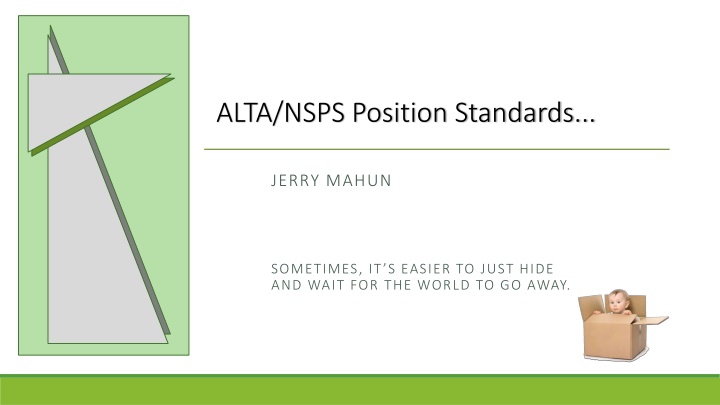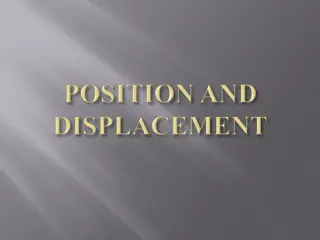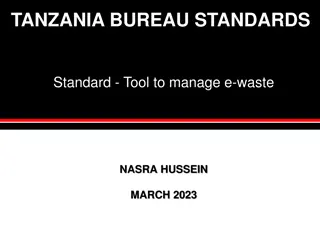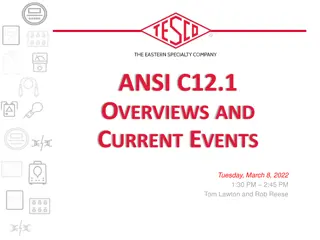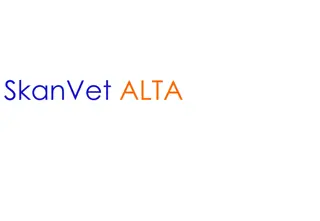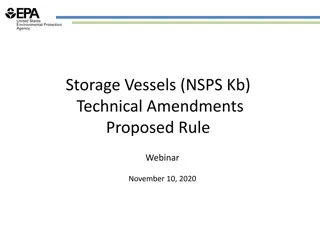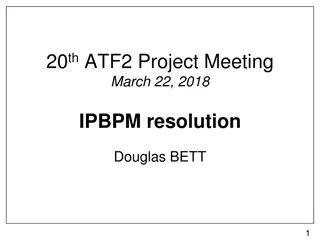ALTA/NSPS Position Standards
Explore the ALTA/NSPS Position Standards governing property surveys, focusing on positional accuracy, precision requirements, and modifications to Wisconsin admin codes. Learn about relative positional accuracy measurements, error ellipses, and maximum allowable deviations between property corners. Dive into the standards for Relative Positional Precision in ALTA/NSPS Land Title Surveys, set at 2 cm plus 50 ppm.
Download Presentation

Please find below an Image/Link to download the presentation.
The content on the website is provided AS IS for your information and personal use only. It may not be sold, licensed, or shared on other websites without obtaining consent from the author.If you encounter any issues during the download, it is possible that the publisher has removed the file from their server.
You are allowed to download the files provided on this website for personal or commercial use, subject to the condition that they are used lawfully. All files are the property of their respective owners.
The content on the website is provided AS IS for your information and personal use only. It may not be sold, licensed, or shared on other websites without obtaining consent from the author.
E N D
Presentation Transcript
ALTA/NSPS Position Standards... JERRY MAHUN SOMETIMES, IT S EASIER TO JUST HIDE AND WAIT FOR THE WORLD TO GO AWAY.
ALTA/NSPS Position Standards Some Background Some Background Wisconsin Admin Code A-E 7 Minimum Standards for Property Surveys Until 2015, minimum positional standards were based on procedures dating back to transit & tape traversing. Hard numbers were: maximum angular misclosure of 0 02 minimum 1/3000 traverse closure WSLS Legislative Committee assisted with updating the standard. Wanted a standard that Raised the (embarrassing low) minimums Was adaptable to contemporary field procedures
ALTA/NSPS Position Standards Some Background Some Background Wisconsin Admin code was modified to include a requirements modeled on the 2011 ALTA/NSPS standard. The added parts are: A-E 7.06 Relative positional accuracy measurements. (1m) Relative positional accuracy shall be the value expressed in feet that represents the uncertainty between points of the boundary of the parcel being surveyed due to random errors in measurements at a 95 percent confidence level. (3) The maximum allowable deviation in relative positional accuracy between any 2 adjacent property corners may not exceed plus or minus 0.13 foot plus 100 parts per million. RPA is relative between any two boundary points. Local v Network accuracy Does not say the RPA is the semi-major axis of an error ellipse.
ALTA/NSPS Position Standards Current ALTA/NSPS Position Standards Current ALTA/NSPS Position Standards 3.E.i. Relative Positional Precision means the length of the semi-major axis, expressed in meters or feet, of the error ellipse representing the uncertainty in the position of the monument or witness marking any boundary corner of the surveyed property relative to the position of the monument or witness marking an immediately adjacent boundary corner of the surveyed property resulting from random errors in the measurements made in determining those positions at the 95 percent confidence level. Relative Positional Precision can be estimated by the results of a correctly weighted least squares adjustment of the survey. Alternatively, Relative Positional Precision can be estimated by the standard deviation of the distance between the monument or witness marking any boundary corner of the surveyed property and the monument or witness marking an immediately adjacent boundary corner of the surveyed property (called local accuracy) that can be computed using the full covariance matrix of the coordinate inverse between any given pair of points, understanding that Relative Positional Precision is based on the 95 percent confidence level, or approximately 2 standard deviations. 3.E.v. The maximum allowable Relative Positional Precision for an ALTA/NSPS Land Title Survey is 2 cm (0.07 feet) plus 50 parts per million (based on the direct distance between the two corners being tested)...
ALTA/NSPS Position Standards Current ALTA/NSPS Position Standards Current ALTA/NSPS Position Standards Error Ellipses N N a95 95% CI Ellipse b95 a b E E P Standard Ellipse a: semi-major axis Absolute: Network Relative: Local
ALTA/NSPS Position Standards The Rabbit Hole The Rabbit Hole Being retired, I should leave well enough alone. But some things bothered me about the Wis standards and, by extension, the ALTA/NSPS standards: 1. What do plus or minus 0.13 foot plus 50 parts per million and 2 cm (0.07 feet) plus 50 parts per million mean? 2. ALTA/NSPS: Relative Positional Precision is based on the 95 percent confidence level, or approximately 2 standard deviations. Dan Rodman, who recently started as an instructor at Madison College, serves as my sounding board. Dan has extensive field experience with newer technology and has been using various adjustment software packages for years. I always learn something every time I discuss an issue with him. (I m trying to talk him into doing some Mentoring Monday presentations).
ALTA/NSPS Position Standards The Rabbit Hole The Rabbit Hole 1. RPP Standard The first issue, numeric interpretation of 2 cm (0.07 feet) plus 50 parts per million RPP is based on random errors, which are small and tend to compensate. They are generally expressed as plus or minus or with a prefix. Examples: Manufacturer State Accuracy for Total Stations and GPS Topcon GTS-30N Series total station The accuracy consists of two parts: a constant uncertainty (contradictory though that may sound) and a proportional one based on distance.
ALTA/NSPS Position Standards The Rabbit Hole The Rabbit Hole 1. RPP Standard How is the RPP between points evaluated? According to Ghilani Adjustment Computations , an error expressed as propagates as an Error of a Sum: Is RPP evaluated the same way or as a simple sum? or
ALTA/NSPS Position Standards The Rabbit Hole The Rabbit Hole 1. RPP Standard Ghilani (and others) treat the two parts as separate random errors. Dan s perspectives It s not inherently truer to treat the constant & proportional parts as independent random errors, and therefore combine them by error of a sum. What matters is how the equipment manufacturer tests and models the error. Trimble engineers say the instrument contribution of EDM random error is a linear sum of the constant & distance dependent portion. ... StarNet has been computing ALTA-NSPS allowable as a linear sum of 0.07 ft + 50 ppm, not error of a sum. I believe Trimble Business Center does a linear sum too, although they only added the test a few years ago. The way it s written, it s not clear what the standard means let alone how adjustments textbooks treat the errors.
ALTA/NSPS Position Standards The Rabbit Hole The Rabbit Hole 1. RPP Standard So, I contacted Gary Kent: The RPP is the maximum against which the adjustment results are judged. How is the RPP computed? As an Error of a Sum or simple sum? This is doubly important as some states have adopted the same maximum error level format for property surveys. In Wisconsin, the language is plus or minus 0.013 foot plus 100 parts per million. without explaining how it is determined. Gary s response: With regard to calculating the RPP of a given coordinate relationship, I agree with you that I think the proper calculation would involve the square root of the sum of the squares. I have cited Ghilani, Brown and Eldridge, and Mikhail and Gracie in my materials. That s how I teach it when the host organization gives me enough time to spend on the topic (although most of the time it seems these days that they want me to cover the entire standards in 2-4 hours, so I don t have time to dwell on RPP). My handout shows the square root of the sum of the squares as the proper calculation. There have been times for sake of time, and to make a brief point, that when showing what is allowed by 0.07 and 50 ppm, I simply add them together, but I tell people the handout goes into much more detail.
ALTA/NSPS Position Standards The Rabbit Hole The Rabbit Hole 1. RPP Standard Is the RPP (0.07 ft + 50 ppm) and evaluated as two independent random errors or as a single summation error? How much of a difference does it make? For a single lot survey that may be: Line (a) Sqrt (b) Sum Diff 150 B C No real significant difference. AB, CD 0.070 0.075 0.005 0.3 ac 100 100 BC, DA 0.070 0.078 0.008 A D 150
ALTA/NSPS Position Standards The Rabbit Hole The Rabbit Hole 1. RPP Standard What about: F Line (a) Sqrt (b) Sum Diff E EF 0.088 0.122 0.034 Now we re seeing some measurable differences. FG 0.099 0.140 0.041 10.5 ac GH 0.125 0.174 0.049 G HE 0.092 0.130 0.038 H
ALTA/NSPS Position Standards The Rabbit Hole The Rabbit Hole 1/9100 1. RPP Standard ALTA/NSPS + Wis Comparisons Both graphs are scaled the same The summation approach is more forgiving. 1/6800 1/13,300 1/17,900
ALTA/NSPS Position Standards The Rabbit Hole The Rabbit Hole 2. 95 percent confidence level, or approximately 2 standard deviations. The second issue is how 95% CI is defined. The 2 Std Dev (aka 2 sigma) multiplier is for a univariate distribution. At that, it s an approximation. Elevation 68% CI 95% CI This is a single variable or single dimension. An example in surveying is elevation determination. MPV
ALTA/NSPS Position Standards The Rabbit Hole The Rabbit Hole 2. 95 percent confidence level, or approximately 2 standard deviations. A horizontal position is a bivariate distribution: North and East have their own standard deviations. These define an error rectangle N -SEP +SNP An error ellipse is tangent to all four sides of the rectangle. Infinite ellipses will fit. The standard error ellipse (SEE) is the one with a maximized semi-major axis and minimized semi-minor. E P -SNP +SEP
ALTA/NSPS Position Standards The Rabbit Hole The Rabbit Hole 2. 95 percent confidence level, or approximately 2 standard deviations. Combining the North and East distribution curves creates a 3D bell-shaped surface. F(N,E) The SEE represents only about 35% horizontal confidence. To increase CI requires scaling the scaling the SEE. But, by how much?
ALTA/NSPS Position Standards The Rabbit Hole The Rabbit Hole 2. 95 percent confidence level, or approximately 2 standard deviations. Because random errors are small and tend to be , repeating measurements gives them greater opportunity to cancel. The more measurements we have, the smaller the SEE area. F(N,E) Technically, the multiplier should be a function of the number of redundant measurements.
ALTA/NSPS Position Standards The Rabbit Hole The Rabbit Hole 2. 95 percent confidence level, or approximately 2 standard deviations. Ghilani, along with other authors, use the F statistic. The multiplier is computed from: FS is the F statistic modifier. It comes from a table based on the CI level and number of redundancies (aka, degrees of freedom, df). A table subset at the 95% CI, along with computed multiplier is shown at right. DF 1 2 3 4 5 10 20 30 FS c 199.5 19.0 9.55 6.94 5.79 4.10 3.49 3.32 19.97 6.16 4.37 3.73 3.40 2.86 2.64 2.58 For c to equal 2 as per ALTA/NSPS, FS would equal 2. The F statistic table in Ghilani s text maxes out at DF = 120 where FS is 3.07. So the 95% CI should be a function of the number of redundancies not a general multiplier.
ALTA/NSPS Position Standards The Rabbit Hole The Rabbit Hole 3. All of which gave rise to a third issue with a few sub-issues. results of a correctly weighted least squares adjustment of the survey. No brainer, right? We all use software which does our adjustments for us. Many packages even include ALTA/NSPS RPP checks. But, some questions about the software: a. If it has an ALTA/NSPS test, how does it compute RPP? Squared or linear? b. How does it scale the SEE? c. Which a priori values, if any, can the user input? How does it use these?
ALTA/NSPS Position Standards The Rabbit Hole The Rabbit Hole 3. All of which gave rise to a third issue with a few sub-issues. results of a correctly weighted least squares adjustment of the survey. a. If it has an ALTA/NSPS test, how does it compute RPP? Squared or linear? Check documentation. Some verbose output files may include this. b. How does it scale the SEE? Dan: Trimble and StarNet use a ~2.45 multiplier F statistic with infinite DF Traverse PC uses F statistic SALSA uses F statistic On top of all that, depending on the results of the Chi Squared test another corrective multiplier may be applied.
ALTA/NSPS Position Standards The Rabbit Hole The Rabbit Hole 3. All of which gave rise to a third issue with a few sub-issues. c. Which a priori values, if any, can the user input? How does it use these to weight the measurements? Here s where we can run into some serious problems. A priori values fall into two general categories - Instrumental: Manufacturer s stated measurement accuracy - Personal: Set up errors, ie, centering These affect weighting and error prorogation.
ALTA/NSPS Position Standards The Rabbit Hole The Rabbit Hole 3. All of which gave rise to a third issue with a few sub-issues. c. Which a priori values, if any, can the user input? How does it use these to weight the measurements? Example: Distance per Ghilani: D Ei Er MSA: (c + p ppm) Others:
ALTA/NSPS Position Standards The Rabbit Hole The Rabbit Hole 3. All of which gave rise to a third issue with a few sub-issues. c. Which a priori values, if any, can the user input? How does it use these to weight the measurements? Example: Angles are even more complex EBS Point & read DBS Inst centering D EAngle Target centering Ei EDIN DFS EFS
ALTA/NSPS Position Standards The Rabbit Hole The Rabbit Hole 3. All of which gave rise to a third issue with a few sub-issues. c. Which a priori values, if any, can the user input? How does it use these to weight the measurements? StarNet allows entry of instrumental and personal a priori values Traverse PC only allows entry of instrumental a priori values.
ALTA/NSPS Position Standards The Rabbit Hole The Rabbit Hole 3. All of which gave rise to a third issue with a few sub-issues. Test Adjustment The same data was adjusted using StarNet and Traverse PC using 95% CI Test data: Seven points Two fixed Five unknown Ten angles Eight distances Eight degrees of freedom Total Station distances: (0.05 ft + 5 ppm) angles: 5 DIN Instrument and target setup errors were not used.
95% CI Ellipse Su 0.105 0.042 0.063 Initial Results Point 1 N E Sn 0.027 0.011 0.016 Se 0.040 0.017 0.023 Sv 0.055 0.041 0.014 T StartNet TPCW 10,388.044 11,086.167 10,387.976 11,086.001 0.068 66-55 23-05 Umm...... diff 0.165 2 StartNet TPCW 12,088.419 11,262.573 12,088.387 11,262.455 0.032 0.049 0.021 0.028 0.050 0.021 0.029 0.138 0.068 0.070 0.100 133-32 0.049 313-32 0.051 Chi-Squared test StarNet: passed TPCW: failed diff 0.118 3 StartNet TPCW 12,151.221 12,151.204 9,796.083 9,796.061 0.022 0.041 0.014 0.027 0.048 0.020 0.028 0.117 0.057 0.060 0.099 0.050 277-26 0.049 82-33 diff 0.017 4 StartNet TPCW 14,169.179 14,169.155 9,471.844 9,471.796 0.048 0.047 0.020 0.027 0.084 0.035 0.049 0.206 0.101 0.105 0.115 0.058 273-11 0.057 86-49 diff 0.023 5 StartNet TPCW 13,491.122 13,491.118 8,251.309 8,251.285 0.024 0.050 0.021 0.029 0.065 0.027 0.038 0.167 0.073 0.094 0.110 0.067 0.043 64-28 25-32 diff 0.004
ALTA/NSPS Position Standards So... So... These two adjustment tests aren t conclusive and bear further investigation including comparing other adjustment software. But a few general observations can be made... The standard could be clearer and more explicitly defined. Surveyors are dependent on software for analysis and adjustment. Does it allow complete a priori input? How are the priori values used to generate weights? How does it scale standard error ellipses? How easy is it to interpret adjustment results?
